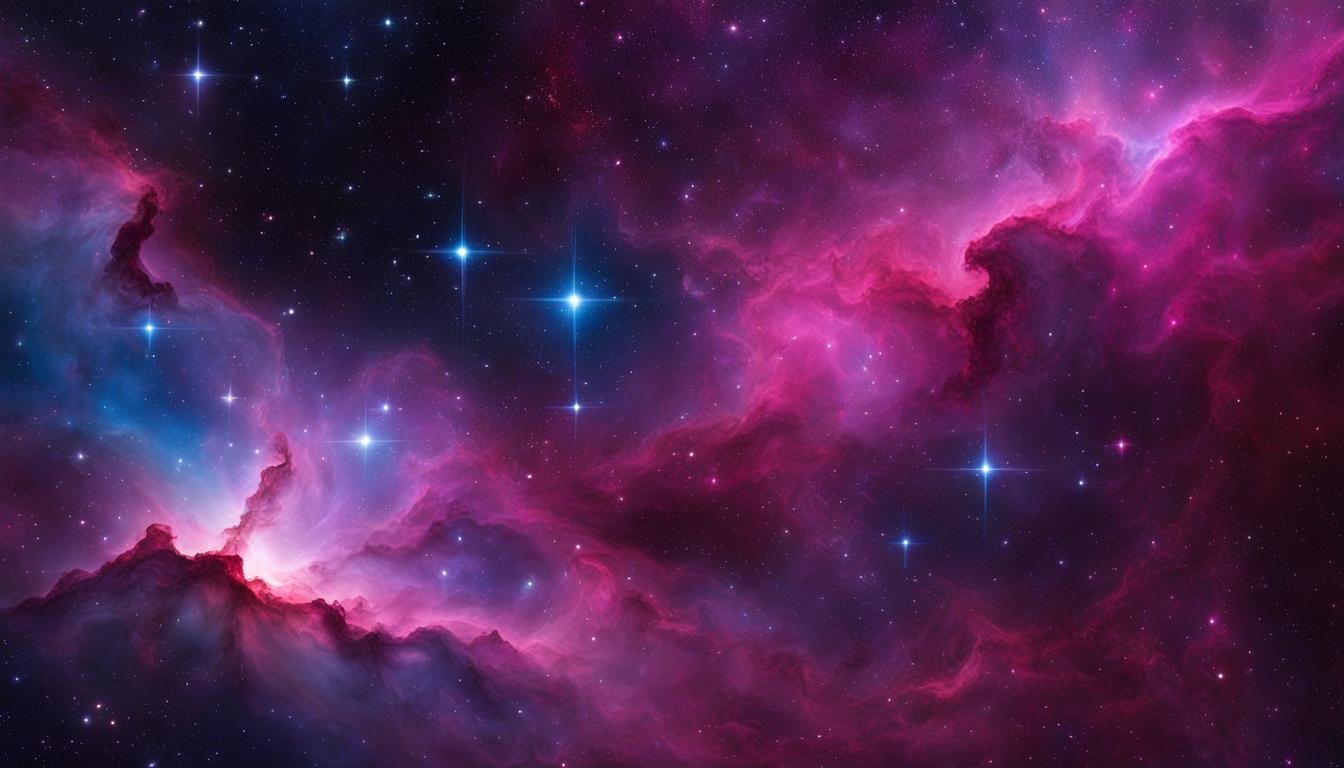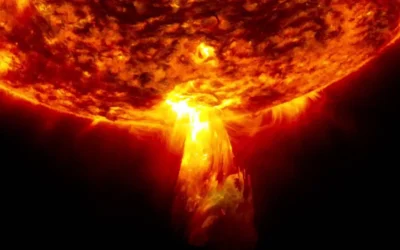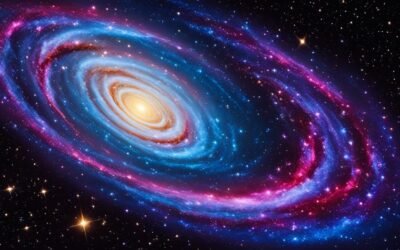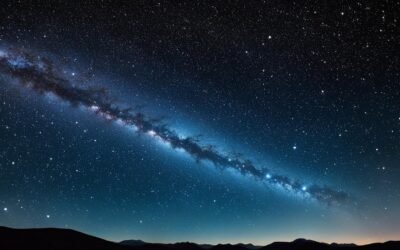Immerse yourself in the celestial beauty of the Merope Nebula, a mesmerizing reflection nebula named after its illuminating star, Merope. Recognized as NGC 1435 and sometimes referred to as Temple’s Nebula, this astronomical phenomenon is a dazzling example of a stellar nursery, ensconced within the renowned Pleiades cluster. Discovered in the 19th century, the Merope Nebula continues to capture the imaginations of astronomers and stargazers alike with its intricate structure and radiant glow, a testament to the ever-unfolding mysteries of our universe.
As a jewel within the vibrant constellation of Taurus, the Merope Nebula resides some 440 light-years away, presenting an expansive view spanning 30 arcminutes across our night sky. At the heart of this breathtaking celestial object is the bright star Merope, whose intense blue light is scattered by the cosmic carbon dust, tinting the nebula in striking shades of blue that are revealed in astronomical imagery.
Key Takeaways
- The Merope Nebula, part of the Pleiades star cluster, is a source of awe and wonder as both a celestial object and an astronomical phenomenon.
- NGC 1435, set within the Taurus constellation, showcases the intricate dance between light and dust across the canvas of space.
- With the star Merope at its core, the nebula’s light is brilliantly reflected by fine carbon particles, creating a signature blue glow.
- Spanning 30 arcminutes in apparent diameter, the nebula reveals the enormous scale and grandeur of such stellar nurseries.
- Step into a universe rich with discovery and immerse yourself in the captivating essence of the Merope Nebula’s radiance.
Unveiling the Merope Nebula: A Celestial Phenomenon
As you gaze upon the tapestry of the night sky, the Merope Nebula emerges as a spectacle of cosmic beauty within the Pleiades star cluster. This nebula captures the essence of space exploration and astronomical observation, alluring star gazers and scientists alike.
The Discovery of Merope Nebula by Wilhelm Tempel
It was the sharp eyes and diligent study of Wilhelm Tempel that brought the Merope Nebula to our collective attention. With modest equipment, a 10.5 cm refractor telescope, Tempel pierced through the void to identify this astronomical wonder. Since that moment, the Merope Nebula, also designated as IC 349, has been a beacon for celestial observers, marking a pivotal chapter in the narrative of space exploration.
The Nebula’s Position in the Pleiades Star Cluster
Residing within the domain of the Taurus constellation, the Pleiades star cluster plays host to the Merope Nebula, enhancing its visual grandeur and scientific value. The relative position of this diffused cloud of interstellar mystery offers a fascinating contrast against the backdrop of the cluster’s luminous stars. This setting within the Pleiades lays the foundation for a deeper understanding of cosmic relationships.
The Bright Knot: IC 349 and its Significance
Among the Merope Nebula’s alluring features, the luminous knot IC 349 stands out. Discovered by Edward Emerson Barnard, this bright knot is nestled close to the star Merope, shrouded by its intense light. The very existence of IC 349 propels this nebula to greater prominence, inviting astrophysicists and amateur astronomers alike to unravel its mysteries.
| Characteristic | Merope Nebula (IC 349) |
|---|---|
| Discovered by | Wilhelm Tempel |
| Apparent Magnitude | 13 (with dimming regions up to magnitude 16) |
| Located In | Pleiades Star Cluster, Taurus Constellation |
| Notable Feature | The bright knot, IC 349 |
| Catalogued by | John Herschel as number 768 |
Embark on the journey to the Merope Nebula, where the essence of the universe unfolds before your eyes—a celestial phenomenon that stands as a testament to humankind’s insatiable curiosity for the cosmos.
The Luminous Merope Star: The Heart of the Nebula
At the heart of the Merope Nebula, a stellar beacon casts its light upon interstellar dust, creating a celestial spectacle known as a reflection nebula. You are gazing upon the Merope star, a blue-white luminary whose radiance is central to the allure and visibility of this astronomical phenomenon. As a subgiant star of spectral class B6IVe, Merope offers a breathtaking sight—a testament to the grandeur of the cosmos.
This star, nestled within the merope star cluster, does more than merely illuminate; it demonstrates remarkable variations in brightness characteristic of a Beta Cephei variable. Its brightness, with an apparent magnitude of 4.113, injects life into the nebula, accentuating the dance of light across the vast canvas of space.
For those who marvel at the grand scope of the universe, Merope stands as a formidable beacon, its intense luminosity 630 times greater than that of our Sun, and its girth spanning four times larger.
The merope star cluster and its heart, the Merope star, continue to mesmerize observers and hold a place of distinction within the pages of astronomical research. Indeed, the scale and splendor of such a subgiant star speak of the mysteries and majesty that astral bodies encapsulate.
Star Formation and the Interstellar Medium Within Merope Nebula
As you delve into the cosmic wonder of the Merope Nebula, you discover an interstellar medium rich with the materials of creation. Often overlooked beyond the dazzling lights of more prominent stars, reflection nebulae like Merope offer a unique look at the intricate mechanisms governing star formation. Situated within this reflection nebula, the Merope Nebula represents a passing cloud interacting with the Pleiades star cluster, a spectacle captured in breathtaking detail by the advancements of astronomical observation.
Reflection Nebulae: Illuminating Interstellar Dust
The enchanting dance of light and matter within the Merope Nebula accentuates the role of cosmic dust in shaping our visual universe. As the nebula reflects the brilliance of Merope, it offers a tantalizing glimpse into the otherwise dark crevices of the cosmos where new stars are birthed from the interstellar medium. Observing these reflections gives scientists a deeper understanding of the characteristics and composition of the cosmic dust layered within these regions.
IC 349: The Bright Knot Near Merope
IC 349, or Barnard’s Merope Nebula, stands out as the Merope Nebula’s brightest segment. This bright knot is a captivating subject for astronomers, shining brightly due to its proximity to the star Merope. Affording exceptional conditions for astronomical observation, the Hubble Space Telescope has documented how starlight from Merope engages with IC 349, shedding light on the fundamental processes that preside over the birth of stars. Such observations are indispensable, allowing us to piece together the puzzle of cosmic evolution and the majestic lifecycle of the stars that bring night skies to life.
The Role of Cosmic Dust in the Merope Nebula
Imagine a celestial canvas painted with the soft glow of starlight, where the Merope Nebula stands out as an astronomical masterpiece. What gives this nebula its enthralling visual character is the cosmic dust that sifts through the nebula, scattering the light to create a spectacle of color. This interplay of dust and light not only offers a window into the complexities of celestial objects for space exploration, but it also accentuates the role of dust in the aesthetics of the universe.
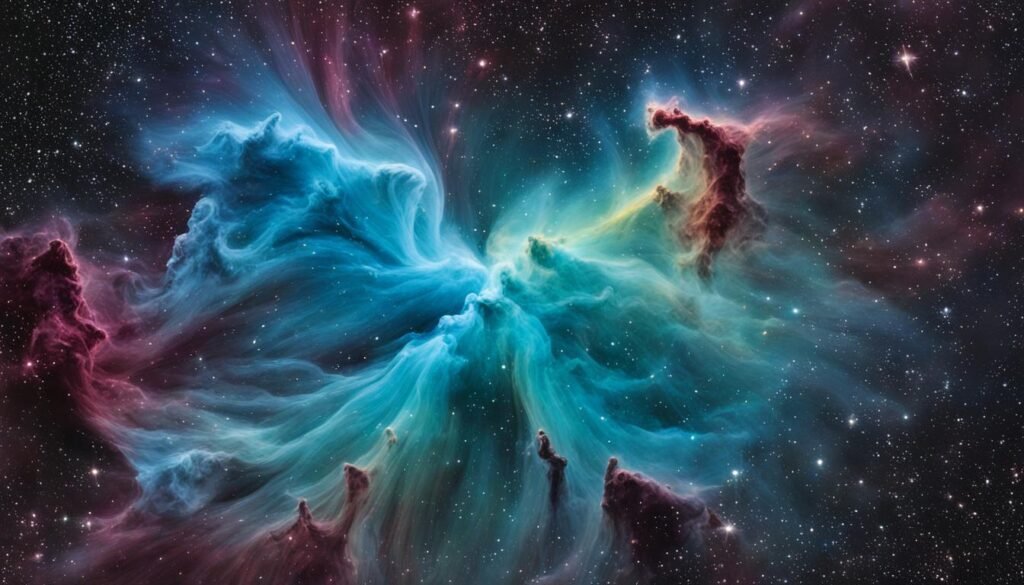
As you gaze into the night sky at the view provided by advanced telescopes, you witness the starlight reflection off of particles much finer than a strand of human hair. These particles, remnants from the formation of stars and planets, are the unsung heroes in the grand ballet of space phenomena.
| Property | Description |
|---|---|
| Composition | Carbonaceous and silicate materials |
| Function | Scatters blue light from the star Merope |
| Significance | Contributes to the study of starlight-matter interaction |
| Observational Relevance | Enhances understanding of nebular and cosmic structure |
The Merope Nebula, bathed in the blue tint of scattered starlight, is more than just a treat for the eyes; it’s a testament to the formative power of cosmic dust. This element reshapes our comprehension of the cosmos, proving that even the smallest particles can have an outsized impact on cosmic scenery. Through space exploration, we continue to uncover the secrets held by cosmic dust, allowing us to marvel at the placid beauty that it brings to the night sky.
Exploring Merope Nebula Through Astronomical Observation
Unlocking the secrets of the cosmos has always been driven by the innovative strides in telescope technology, with the Merope Nebula emerging as a sparkling example. Your journey into the realm of astronomical observation brings you face-to-face with the delicate interplay of light and dust within this celestial enigma. Let’s delve into how the latest advancements from space exploration endeavors have enhanced our understanding of the universe’s beauties.
Advancements in Telescope Technology
From the ground-based behemoths to the orbiting observatories, telescope technology has come a long way since the Merope Nebula’s initial discovery. The intricate dance of cosmic particles within the nebula can now be appreciated in far greater detail, thanks to these advancements.
Hubble Space Telescope’s Contribution to Understanding Merope Nebula
Quite possibly, the most significant leap forward in our celestial quest has been made by the venerable Hubble Space Telescope. This pioneering observatory has served as humanity’s eye in the sky, piercing through the veil of space and time to bring us closer to the wonders it beholds, such as the Merope Nebula.
| Feature | Hubble Space Telescope | Ground-Based Telescopes |
|---|---|---|
| Resolution | Unmatched clarity eliminating atmospheric distortions | Limited by Earth’s atmosphere |
| Access to Spectra | Broadband spectral access without atmospheric interference | Restricted spectral ranges due to atmospheric absorption |
| Observation Time | Extended undisturbed observation capabilities | Subject to weather and day-night cycle |
| Technological Innovation | State-of-the-art instruments and regular upgrades | Varies significantly across different observatories |
With technological advancements continuing to surge forward, your fascination with the Merope Nebula and other celestial marvels is sure to be met with even more stunning revelations in the years to come. The contributions of the Hubble Space Telescope stand as a testament to human ingenuity in the perpetual quest for knowledge in space exploration.
Navigating the Pleiades Cluster: Home to Merope Nebula
As you gaze up at the winter sky, the Pleiades cluster, also known as the sparkling “Seven Sisters,” presents itself as a stunning collection of celestial objects, among which the radiant Merope Nebula stands out. This astronomical phenomenon is a testament to the grandeur of the cosmos, showcasing a beautiful interplay of star formation and cosmic brilliance.
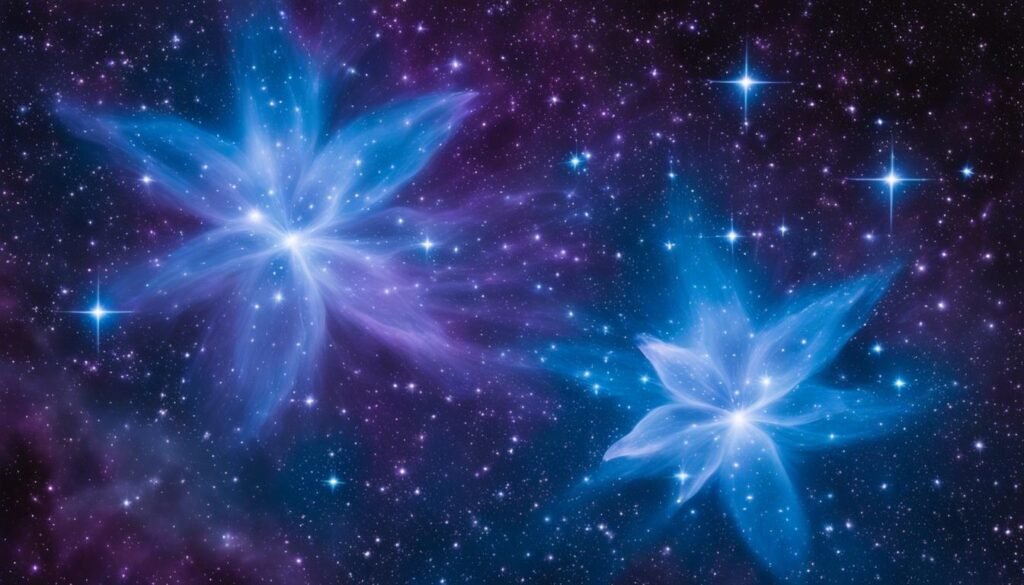
The Taurus constellation is home to this famous cluster, a beacon of light in the darkness, beloved by astronomers and amateurs alike. By understanding the positioning of the Merope Nebula within the cluster, you capture a glimpse into the symbiotic relationship between clusters of young stars and the nebulae they encapsulate.
“The Pleiades Cluster, with its blue stars weaving through the night, serves not only as a guide to our cosmic neighborhood but also as a gateway to the universe beyond.”
Witnessing the Pleiades cluster is more than just a visual feast; it is an exploration into the history of the universe, as each celestial object within it narrates a story of its own. The Merope Nebula, like a cosmic jewel, offers clarity on the processes that govern the cosmos, particularly the majestic phenomenon of starlight reflecting off interstellar dust.
Celestial events and objects within the Pleiades cluster, visible to the naked eye under the right conditions, become even more intriguing when observed through the lens of powerful telescopes, revealing the beauty and complexity of astronomical phenomena such as the Merope Nebula. Let the allure of these stars and nebulae guide your curiosity to unlock the secrets they hold.
The Interaction Between Merope Nebula and Merope Star
As you gaze upon the vibrant Pleiades cluster, it is hard to overlook the cosmic expanse of the Merope Nebula as it gracefully waltzes through space. This astronomical marvel showcases the profound effects of radiation pressure emanating from the blinding luster of the Merope Star.
Radiation Pressure and its Impact on Nebular Dust
The radiant output from the Merope Star exerts a powerful influence on the surrounding nebular dust. This phenomenon, known as radiation pressure, results in a compelling segregation of dust particles. With delicate precision, this process sifts through the particles, causing them to drift and spiral in a mesmerizing celestial dance that can only be described as otherworldly.
The Drifting Dance of Merope Nebula Through Space
At a velocity of approximately 11 kilometers per second, the Merope Nebula is not merely an inert cloud but an ever-changing tapestry, richly interwoven with particle movement and light. Through the lens of the Hubble Space Telescope, we are afforded a rare glimpse into this dynamic interaction—a breathtaking display of the universe’s grandeur in motion.
Historical Observations and Cataloging of Merope Nebula
As you step back in time to explore the rich history of celestial documentation, you’ll uncover the meticulous efforts of past astronomers who turned their gaze and telescopes toward the heavens, bringing clarity to the cosmos. The Merope Nebula, a celestial tapestry interwoven with stellar light and cosmic dust, owes much of its recognition to these early pioneers of the skies. Their observations have etched a roadmap for understanding the complexities of this astronomical marvel.
John Herschel’s Cataloging Efforts
Among those pioneers, John Herschel stands out for his expansive work in cataloging the night sky, detailing numerous celestial bodies for the legions of astronomers who would follow in his wake. One of these bodies was the luminous Merope Nebula, which he admirably recorded as GC 768 within his General Catalogue. Herschel’s historical observations contributed significantly to the nebula’s notability and further inspection, cementing its role in the annals of space exploration.
Edward Emerson Barnard and the Discovery of IC 349
In the lineage of great astronomical contributors, Edward Emerson Barnard’s name glimmers as brightly as the subjects of his study. Through his precise and unwavering focus, Barnard uncovered the brightest fragment of the Merope Nebula, known as IC 349. Utilizing advanced optics of his era permitted him to discern this brilliant knot near the Merope star. Barnard’s discovery, along with his intricate cataloging, bolstered the celestial significance of the Merope Nebula, allowing it to shine across the eons as a cornerstone of celestial observation and understanding.
FAQ
What is the Merope Nebula?
The Merope Nebula, also known as Tempel’s Nebula or NGC 1435, is a reflection nebula situated within the Pleiades star cluster, approximately 440 light-years away in the constellation Taurus. It is part of a larger celestial object and stellar nursery region filled with cosmic dust and gas that reflects starlight, creating an observable astronomical phenomenon.
Who discovered the Merope Nebula and when?
The Merope Nebula was discovered by the German astronomer Wilhelm Tempel on October 19, 1859. Tempel observed the nebula through a 10.5 cm refractor telescope, which allowed him to recognize this faint celestial object within the Pleiades star cluster.
What relationship does the Merope Nebula have with the Pleiades star cluster?
The Merope Nebula is located within the Pleiades star cluster – a prominent cluster in the Taurus constellation, often referred to as the “Seven Sisters.” It is not involved in the star formation of the Pleiades but is a separate interstellar cloud through which the celestial cluster is currently passing.
What is the significance of IC 349 within the Merope Nebula?
IC 349, also known as Barnard’s Merope Nebula, is a bright knot within the Merope Nebula, discovered by Edward Emerson Barnard. It is particularly bright due to its close proximity to the Merope star, and it plays a significant role in revealing how interstellar dust interacts with intense starlight.
How does the Merope star contribute to the Merope Nebula?
The Merope star, with its blue-white subgiant characteristics and spectral class of B6IVe, is the primary source of light for the Merope Nebula, which reflects the star’s luminosity. This star’s intense brightness and radiation illuminate the surrounding dust, making the nebula visible as a reflection nebula.
What is a reflection nebula, and how does it relate to the Merope Nebula?
A reflection nebula is a cloud of interstellar dust and gas that, rather than emitting its own light, reflects the light of nearby stars. The Merope Nebula is a prime example, as it reflects the light of the Merope star, showcasing the interplay between cosmic dust and stellar radiation.
What is the role of cosmic dust in the appearance of the Merope Nebula?
Cosmic dust within the Merope Nebula scatters the light, particularly the blue light from the Merope star. This scattering is what gives the nebula its distinctive blue hue and allows it to be observed as a celestial object in space exploration and astronomy.
How has telescope technology improved the study of the Merope Nebula?
Advancements in telescope technology have greatly enhanced the study of the Merope Nebula, from Wilhelm Tempel’s early observation to high-resolution images captured by the Hubble Space Telescope. Such technological improvements allow researchers to scrutinize the intricate details and structure of the nebula.
What does the Pleiades Cluster have to do with the Merope Nebula?
The Pleiades Cluster, which houses the Merope Nebula, serves as a significant celestial backdrop, enriching its astronomical appeal. The close association between the cluster’s stars and the nebula provides a unique insight into the relationship between star clusters and interstellar clouds.
How does radiation pressure affect the Merope Nebula?
Radiation pressure exerted by the Merope star influences the movement and structure of the nebular dust within the Merope Nebula. This pressure can sift through dust particles by size, creating a visible separation and an attractive astronomical phenomenon that is observable with advanced telescopes.
What historic efforts have been made to catalog the Merope Nebula?
The Merope Nebula was cataloged by John Herschel as GC 768 in his General Catalogue of Nebulae and Clusters of Stars. Later, Edward Emerson Barnard contributed to the nebula’s historical observations by discovering IC 349 and adding significant data to its understanding and cataloging.



